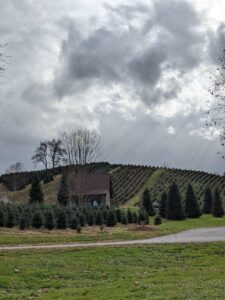Christmas Tree Supply 2021
go.ncsu.edu/readext?833992
en Español / em Português
El inglés es el idioma de control de esta página. En la medida en que haya algún conflicto entre la traducción al inglés y la traducción, el inglés prevalece.
Al hacer clic en el enlace de traducción se activa un servicio de traducción gratuito para convertir la página al español. Al igual que con cualquier traducción por Internet, la conversión no es sensible al contexto y puede que no traduzca el texto en su significado original. NC State Extension no garantiza la exactitud del texto traducido. Por favor, tenga en cuenta que algunas aplicaciones y/o servicios pueden no funcionar como se espera cuando se traducen.
Português
Inglês é o idioma de controle desta página. Na medida que haja algum conflito entre o texto original em Inglês e a tradução, o Inglês prevalece.
Ao clicar no link de tradução, um serviço gratuito de tradução será ativado para converter a página para o Português. Como em qualquer tradução pela internet, a conversão não é sensivel ao contexto e pode não ocorrer a tradução para o significado orginal. O serviço de Extensão da Carolina do Norte (NC State Extension) não garante a exatidão do texto traduzido. Por favor, observe que algumas funções ou serviços podem não funcionar como esperado após a tradução.
English
English is the controlling language of this page. To the extent there is any conflict between the English text and the translation, English controls.
Clicking on the translation link activates a free translation service to convert the page to Spanish. As with any Internet translation, the conversion is not context-sensitive and may not translate the text to its original meaning. NC State Extension does not guarantee the accuracy of the translated text. Please note that some applications and/or services may not function as expected when translated.
Collapse ▲According to an article from NC State University College of Agriculture and Consumer Science news services, “North Carolina’s Christmas tree growers are busy harvesting to prepare to supply roughly 5 million trees by Thanksgiving – hustling to meet a demand that experts think will be high this year.”
The article continues, “North Carolina customers should consider themselves among the luckiest in the United States,” said Travis Birdsell, an Extension agent for NC State University who works directly with Christmas tree farmers in the state. “They’re close to one of the largest Christmas tree growing regions in the United States. A lot of the stores are supplied directly by growers, so they have a direct supply of trees.”
The author asked Birdsell about the supply and of live Christmas trees in North Carolina. The article states that “he works directly with Christmas tree farmers in Ashe County, North Carolina, which has ranked among the top Christmas tree producing counties in the nation. In 2017, there were nearly 1.9 million Christmas trees cut in the county, according to the National Agricultural Statistics Service.”
Facts about the North Carolina Christmas Tree Supply in 2021
In the article, Travis Birdsell, an Extension agent for NC State University who works directly with Christmas tree farmers in the state, provides the following facts:
- North Carolina is the largest Christmas tree producing region east of the Rockies and we’re sending out about the same amount of trees as we have in the past several years, so I would say our supply is the same. It’s the demand that has gone up. We continue to get more and more phone calls trying to fill orders across the country.
- We may see some regional fluctuations in tree demand based on holiday travel. When we were all staying home last year, a lot more people opted to include a real tree in their Christmas traditions. And if supply can’t increase, then it will look like we are short.
- Part of the reason we can’t respond quickly to an increase in tree demand is due to the growing cycle. Christmas trees are on an eight-to-10-year growing cycle. If you look eight to 10 years back, we were just coming out of the Great Recession. People had to make some tough decisions and putting up a real Christmas tree was a bit of a luxury item then. Some went without a Christmas tree at all.
- In the mountains of North Carolina, Fraser fir is the primary species grown. Fraser firs represent about 94% of the Christmas trees grown in North Carolina. The piedmont and eastern North Carolina regions make up that other percentage and grow a variety of other species because Fraser firs cannot grow in those climates.
- Choose-and-cuts have a set amount of land, and they grow the same amount on that land every year. What happens though is that people can’t find a tree at their usual retail lot, and then they decide to go to a choose-and-cut. They start getting hit harder and harder.
- For the greatest selection and availability, people should plan to find their tree within the first two weeks of the Christmas tree shopping season, which starts after Thanksgiving. They’ll probably close by mid-December. This is a good year to maybe try something new – whether that’s a new size or a new species – if you can’t find what you’re looking for. Natural trees, which are more layered, should be in good supply this year. Also, you should call ahead – whether it’s to the retail lot or a cut-your-own farm.





